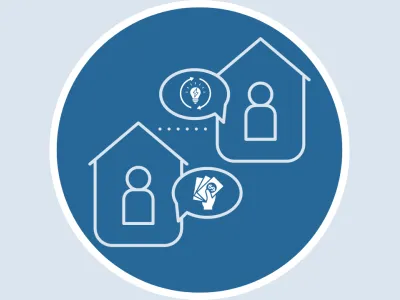What do your neighbors think about the clean energy transition?

Through my environmental policy program at the University of Minnesota Humphrey School of Public Affairs, I have had the opportunity to analyze and discuss a variety of policies in the context of the clean energy transition. With the passage of federal legislation like the Inflation Reduction Act (IRA) in 2022, and Governor Walz signing the 100% carbon-free electricity by 2040 bill, it has been quite the exciting year to be an environmental policy student.
What I learn in the classroom informs my work at the Citizens Utility Board (CUB) and vice versa. My involvement with CUB’s outreach efforts has allowed me to gain a more holistic perspective on complex topics related to the clean energy transition, and what role CUB plays in these exciting and changing times.
CUB’s outreach team attends a variety of events in both rural and metro regions of Minnesota. I’ve had the pleasure of speaking with hundreds of Minnesota residents from a variety of socioeconomic backgrounds about all sorts of energy topics. The clean energy transition is often a focal point of my conversations with residents. Several recurring questions have been raised by Minnesotans regarding the clean energy transition in Minnesota, ranging from system-wide challenges such as grid reliability, to household specific concerns like the cost to upgrade home energy use from gas to electric systems, when to upgrade, and where to begin.
System-Wide Concerns: Grid reliability
Some Minnesota residents are skeptical that the existing electrical grid is sufficient to support an increased electrical load from Minnesota energy consumers. They also worry whether clean energy projects can provide enough power when its needed. Often, they point to other states’ experiences with grid reliability, such as California, and how their grids have not been able to keep up with the extreme weather events. Hearing statements like these is invaluable for CUB. CUB needs to hear worries and concerns so we can advocate on behalf of ratepayers for affordable, equitable, and reliable clean energy services.
Household Concerns: How to participate in the clean energy transition
At the individual household level, renters and homeowners share uncertainty regarding their ability to participate in the clean energy transition. Here are some of the biggest questions we run into:
Concern #1: Cost to upgrade
Minnesota homeowners who are interested in electrifying their heating and cooling systems through the use of air source heat pumps (“ASHPs”) may still need a backup furnace or boiler to keep their homes comfortable during the coldest times of the year. Even though installing ASHPs can eliminate the need for an air conditioner, the cost of maintaining both an electric heating system and a fossil fuel (gas, propane or heating oil) backup can be financially difficult. Often, the stress of navigating the different financial options leads to great hesitation from homeowners to participate. Upgrading to a dual-fuel system raises additional concerns of when to upgrade as well.
Concern #2: When to upgrade
Two homeowners I spoke to shared their experience of converting from a gas heating system to a dual-fuel system, noting that they kept their existing gas heating equipment and added on a new electric heat pump. While financial incentives were not their primary reason for getting a heat pump, the couple was hoping to access rebates or tax incentives through the IRA. Unfortunately, they were unable to qualify as their existing gas heating system did not meet the standards set by the IRA. As homeowners consider upgrading to an electric or dual-fuel heating system, they should keep in mind the age of the existing heating system, and whether or not the ASHP equipment it is paired with is eligible for utility rebates and/or federal IRA incentives.
Another important consideration is the availability of the different financial benefits. Federal tax incentives are currently available, and federal rebates for households up to150% of the area median income will be available at a future date. Those at or below 80% of the area median income will be eligible for the highest incentives. The state of Minnesota will also be offering future incentives for some measures. Utilities also offer rebates and will have new offerings in 2024. Depending on your income eligibility for incentives, financial situation, or urgency for new equipment, some residents may choose to wait until additional rebates are available to reduce the cost of their upgrade.
Concern #3: Where to start
Finally, homeowners and renters are often uncertain about where to start their clean energy journey. A good first step is to think about your electrification and comfort goals for your home. Then, create a plan and budget while keeping in mind factors like equipment/appliance end of life, weatherization needs, electrical upgrade needs, and your expected length of stay in the home.
It is important to note that each household is unique. CUB’s staff are more than happy to talk to you about your specific household needs to help you sort out your energy plans in a way that meets you where you’re at. During this clean energy transition, I have witnessed CUB serve as an effective mediator between legislators, commissioners, and consumers. As a consumer advocate, CUB wants to hear your thoughts and concerns on topics like the clean energy transition. If you see us at an event, please say hi and share your opinions and experiences with us!